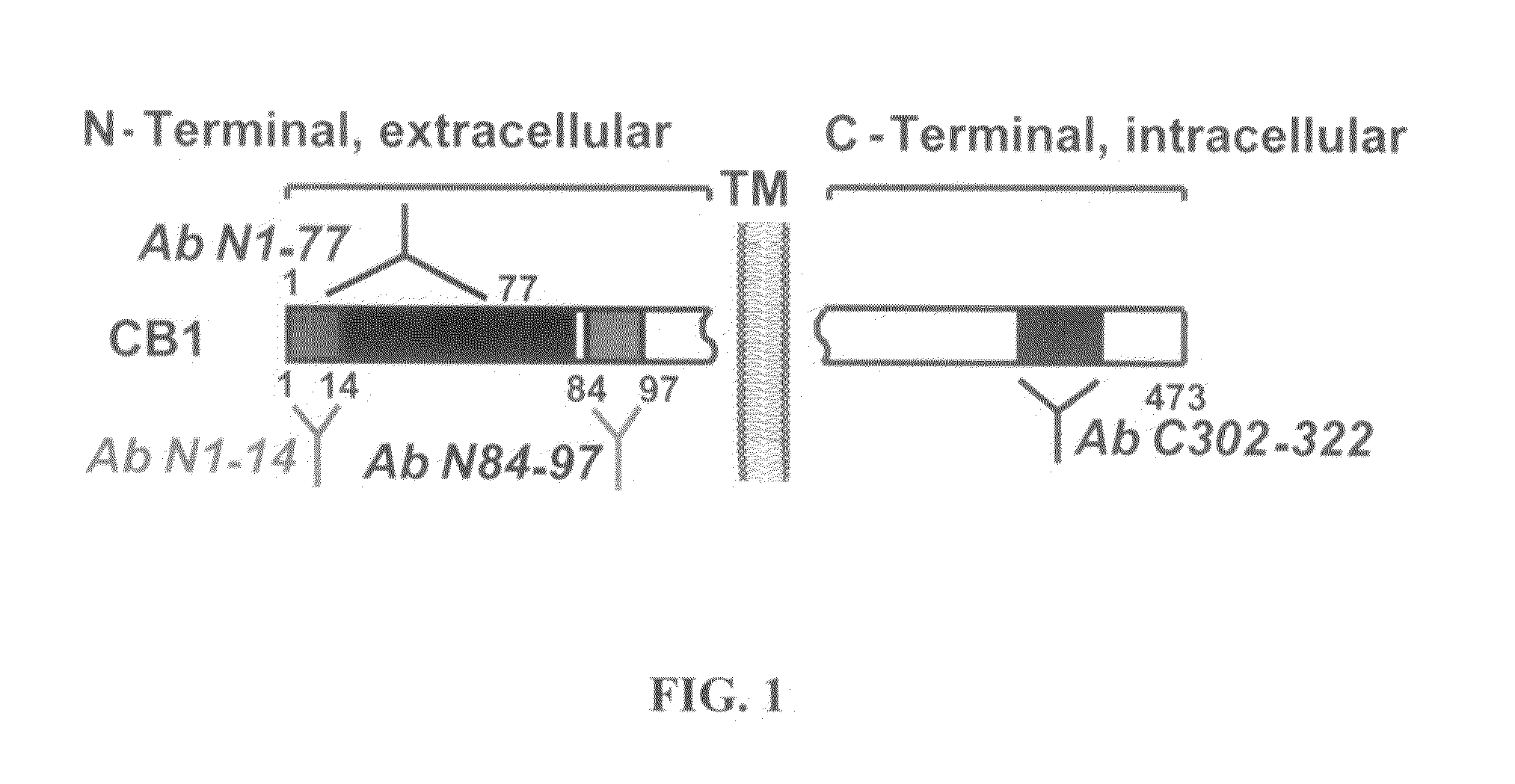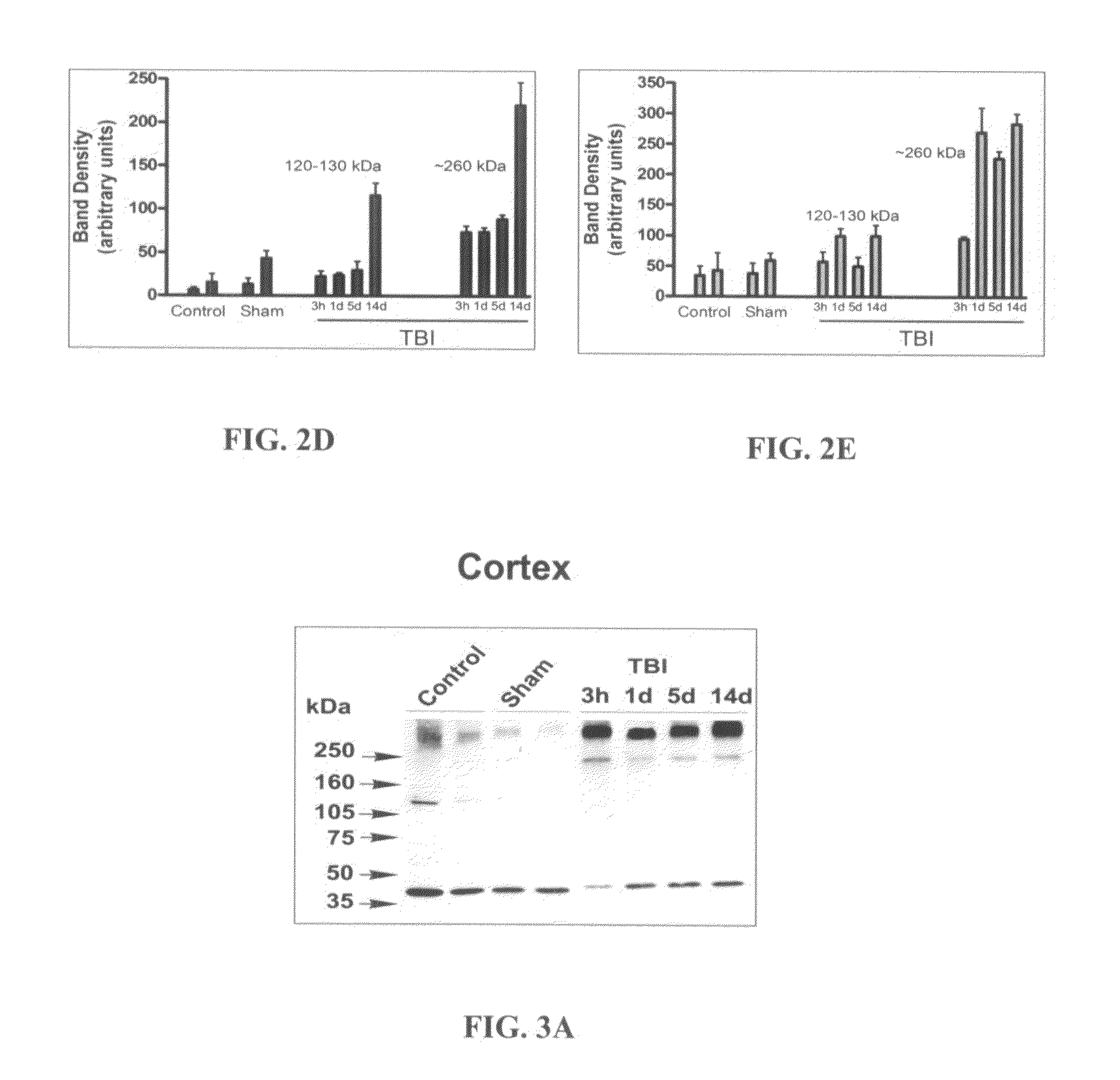Detection of cannabinoid receptor biomarkers and uses thereof
- Summary
- Abstract
- Description
- Claims
- Application Information
AI Technical Summary
Benefits of technology
Problems solved by technology
Method used
Image
Examples
example 1
[0280]Endocannabinoids anandamide (AA) and 2-arachidonoyl-glycerol (2-AG) can be produced upon brain damage and, possibly instigate neuroprotective effect. AA and 2-AG act via G protein-coupled (GPCR) central type of cannabinoid receptors CB1, which undergo desensitization and internalization upon activation with AA or 2-AG. It is not clear whether CB1 receptor, like several other GPCR (e.g. GABAA-R, opiate-R), can form oligomeric complexes in the brain. CB1 receptors have not been characterized following traumatic brain injury (TBI). Therefore, the objective was to proteomic profiling of CB1 receptor complexes in rat cortex, hippocampus and CSF after TBI to ascertain its pathogenic and diagnostic significance.
[0281]Without wishing to be bound by theory, it is hypothesized that CB1 receptors occur in rat brain as both monomers and oligomeric complexes; TBI results in degradation of CB1 monomers and formation of oligomeric complexes in injured cortex and hippocampus; CB1 complexes ma...
example 2
Cell Therapy and Neurogenesis
[0285]Identification of molecular mediators for directed manipulation of stem / progenitor cells is essential for cell therapy and stimulation of endogenous neurogenesis. We have shown that pro-survival lipid lysophosphatidic acid (LPA) instigated clonal generation of mouse neurospheres via LPA receptor-dependent proliferation of AC133 positive neural progenitors. Given a structural and receptor homology between LPA and endocannabinoids anandamide(AEA) and 2-arachidonoyl glycerol (2-AG), we suggested that the endocannabinoid system can play a role in development of neural progenitors. A strong expression of cannabinoid receptors CB1 was found in mouse clonal neurospheres generated by EGF / FGF2 or LPA. CB1 receptor was expressed in the core of neurosphere and partially co-localized with LPA receptor and AC133. In neurospheres differentiated on an adherent matrix with EGF / FGF2, CB1 expression was restricted to cells of neuronal lineage. In contrast, neurosph...
example 3
Endoantibodiess, and Their Receptors in the Development of Neural Progenitors
[0288]Identification and characterization of endogenous molecules which stimulate proliferation / differentiation of neural stem cells is crucial for development of novel treatments for devastating diseases. We have recently discovered that lysophosphatidic acid (LPA), a precursor of endocannabinoid 2-AG, and 2-AG itself instigated clonal generation of neurospheres from dissociated mouse postnatal forebrain. Clonal expansion of these cells by LPA and 2-AG was inhibited by DGPP and AM251, antagonists of LPA and CB1 receptors, respectively. Potential roles for endocannabinoids anandamide and 2-AG in neural progenitor development, particularly after brain injury, has not been studied. We hypothesize that expression of CB1 receptors and up-regulation of endocannabinoids, represents a crucial mechanism of neural progenitor activation during brain injury, and that endocannabinoids are endogenous mediators which m...
PUM
| Property | Measurement | Unit |
|---|---|---|
| Time | aaaaa | aaaaa |
| Time | aaaaa | aaaaa |
| Time | aaaaa | aaaaa |
Abstract
Description
Claims
Application Information
 Login to view more
Login to view more - R&D Engineer
- R&D Manager
- IP Professional
- Industry Leading Data Capabilities
- Powerful AI technology
- Patent DNA Extraction
Browse by: Latest US Patents, China's latest patents, Technical Efficacy Thesaurus, Application Domain, Technology Topic.
© 2024 PatSnap. All rights reserved.Legal|Privacy policy|Modern Slavery Act Transparency Statement|Sitemap



